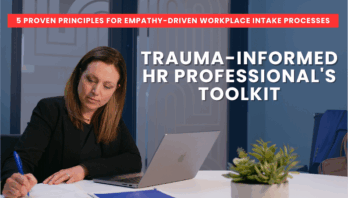By Sarah Niman
During a recent interview, I detected telltale nervousness signs: fast speech, fidgeting hands and frequent interruptions. This is typical, but it was beginning to stifle the evidence he was there to provide. I reminded him what we discussed ahead of the interview: That his side of the story was important to share, and that he could rely on the notes he prepared ahead of time to ground himself during his interview. While he likely remained nervous, he slowed down, reviewed his notes, and shared his story.
Most people taking part in an investigation find them uncomfortable, scary and unfamiliar. This unease can run from sweaty palms and fast heart rate all the way to visceral overwhelm and panic. As investigators, we realized we needed to account for this or risk gathering sub-par, unreliable evidence.
Enter the Person-Centered approach to investigations: Person-Centered investigations directly address the participation barriers people face to providing useful, detailed evidence. This approach asks us to depart from traditional, system-based interview plans, and instead figure out how to help each person feel comfortable providing their evidence.
Person-Centered care is gaining traction among healthcare professionals and advocacy groups, but investigators are just starting to integrate this approach into our interviews.
A Person-Centered approach is not just a nice aspiration, it aligns with each person’s fundamental right to a fair investigation. A tenet of our legal system is to gather and consider evidence directly relevant to what the person did or did not do, not limited by barriers witnesses may face in providing that evidence in the first place.
Since evidence plays a truth-seeking function in investigations, an investigator must adapt and build our practices to reflect research-based approaches that improve evidence collection, including Person-Centered interviews.
Person-Centered care took root when the US-based advocacy group Administration for Community Living (ACL) coined the term “person-centered, trauma-informed,” (PCTI) in 2015 to describe its goal to promote dignity, strength, and empowerment by considering the trauma in peoples’ lives into the agency’s programs, policies, and procedures.
The ACL’s Key Aspects of the Person-Centered approach apply to our investigations as follows:
- Empower them: Accommodate an interviewee’s wishes and interests while balancing our obligations as investigators.
- Respect timing: Don’t impose stringent time limits on the interviews, if possible.
- Tailor responses: Find the best solution, considering the interviewee’s specific circumstances and needs.
- Prioritize wellbeing: Take breaks, encourage them to seek supports, help them to access the interview.
- Distinguish between what is best for me and what is best for the interviewee.
- Involve them: Communicate directly rather than discussing them without their involvement.
- Listen: Don’t just give instructions on how the interview will proceed.
- Collaborate: Plan with the person rather than imposing plans on them.
- Be flexible: The approach that worked for other investigations may not work for each interviewee.
- Name the power dynamics at play and work to reduce the power gap.
Our team at Barker Hutchinson recently developed the following reflection questions, which are intended to prompt investigators to find their biases, triggers and reactions when first beginning a Person-Centered investigation:
- What social identities—race, gender, sexual orientation, age, social class, religion, ability and so on—do I identify with and how significant is each identity to my investigation practice?
- What type of training, experiences, and professional designations do I have? How have they shaped who I am professionally, and how might they affect how this interviewee will relate to me and my interviewing style?
- What knowledge and experience do I have related to the subject matter of the investigation? How did I gain that knowledge?
- Does my knowledge, experience, and identity position me more closely to one investigation party than another? If so, how might that affect my ability to build trust, empathy, and rapport with the party I appear less similar to?
- What elements of my identity, experiences, and worldviews shape my approach to investigations and interviewing? How do my intersecting identities shape my views of what it means to be “polite,” “friendly,” “professional,” etc.?
We also developed the following questions to explore about an interviewee:
- What do I know about the interviewee’s social identities and how significant they are to the issues under investigation?
- What do I know about the interviewee’s training, experiences, and professional designations and how significant they are to the issues under investigation? How might this affect their experience of me and my investigation and interviewing practice?
- What position does this interviewee occupy relative to other investigation parties? How might this change their view of where I stand relative to them and the other investigation parties?
- How might the interviewee’s intersecting identities shape their views of what it means to be “polite,” “friendly,” “professional,” etc.?
The Person-Centered approach doesn’t ask me to ignore or stuff down my reactions to these questions; it asks me to take the necessary time to find and name my reactions, biases, and triggers so I can manage them, keeping the interviewee the central focus when gathering evidence.






